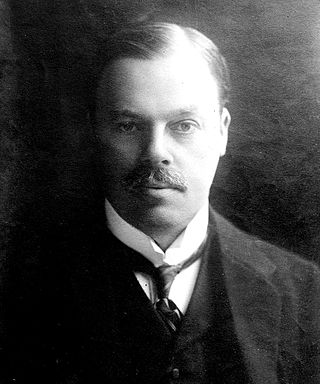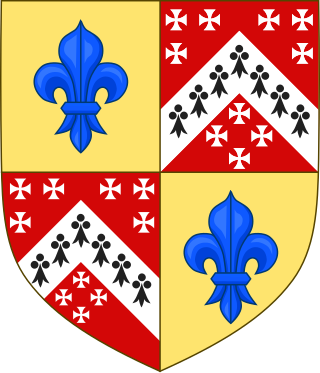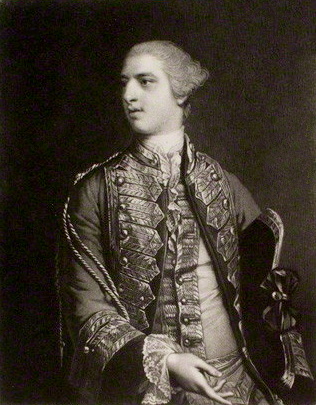Arms
 |
|
Viscount Camrose, of Hackwood Park in the County of Hampshire, is a title in the Peerage of the United Kingdom. It was created on 20 January 1941 for the prominent newspaper magnate William Berry, 1st Baron Camrose. [1] He had previously received the award of Baronet, of Long Cross in the County of Surrey, in the Baronetage of the United Kingdom, on 4 July 1921, [2] and was created Baron Camrose, of Long Cross in the County of Surrey, on 19 June 1929, in the Peerage of the United Kingdom. [3] His second son, the third Viscount, disclaimed the peerages in 1995 on succeeding his elder brother. [4] However, he had already been created a life peer as Baron Hartwell, of Peterborough Court in the City of London, on 19 January 1968. [5] On his death in 2001 the life peerage became extinct while he was succeeded in the other titles by his eldest son, the fourth Viscount. The first three Viscounts all headed The Daily Telegraph at one point, the first having purchased it from Harry Levy-Lawson, 1st Viscount Burnham, but in the 1980s they lost control to Conrad Black.
The first Viscount was the younger brother of the industrialist Henry Berry, 1st Baron Buckland, and the elder brother of fellow press lord Gomer Berry, 1st Viscount Kemsley.
In a March 2022 by-election, the 5th Viscount was elected to replace Lord Rotherwick in the House of Lords following Rotherwick's retirement in February 2022. [6]
The heir apparent is the present holder's elder son, the Hon. Hugo William Berry (b. 2000)
 |
|

Earl of Sandwich is a noble title in the Peerage of England, held since its creation by the House of Montagu. It is nominally associated with Sandwich, Kent. It was created in 1660 for the prominent naval commander Admiral Sir Edward Montagu. He was made Baron Montagu of St Neots, of St Neots in the County of Huntingdon, and Viscount Hinchingbrooke, at the same time, also in the Peerage of England. The viscountcy is used as the courtesy title by the heir apparent to the earldom. A member of the prominent Montagu family, Lord Sandwich was the son of Sir Sidney Montagu, youngest brother of Henry Montagu, 1st Earl of Manchester, and Edward Montagu, 1st Baron Montagu of Boughton.

Viscount Stansgate, of Stansgate in the County of Essex, is a title in the Peerage of the United Kingdom. It was created in 1942 for the Labour politician, former Secretary of State for India and future Secretary of State for Air, William Wedgwood Benn. He was the second son of Sir John Benn, 1st Baronet, of The Old Knoll. Stansgate's eldest son and heir apparent, Michael Benn, was later killed in the Second World War. Consequently, he was succeeded in the title by his second son, the Labour politician Tony Benn, who disclaimed the peerage on 31 July 1963, the day the Peerage Act 1963 passed into law and made it possible for him to do so. As of 2022, the title is held by Tony Benn's eldest son, Stephen Benn, 3rd Viscount Stansgate.

Viscount Hailsham, of Hailsham in the County of Sussex, is a title in the Peerage of the United Kingdom. It was created in 1929 for the lawyer and Conservative politician Douglas Hogg, 1st Baron Hailsham, who twice served as Lord High Chancellor of the Great Britain. He had already been created Baron Hailsham, of Hailsham in the County of Sussex, in 1928, also in the Peerage of the United Kingdom. Hogg was the son of the merchant and philanthropist Quintin Hogg, seventh son of Sir James Hogg, 1st Baronet, whose eldest son James McGarel-Hogg, 2nd Baronet was created Baron Magheramorne in the Peerage of the United Kingdom in 1887.

Earl of Listowel is a title in the Peerage of Ireland. It was created in 1822 for William Hare, 1st Viscount Ennismore and Listowel, who had earlier represented Cork City and Athy in the Irish House of Commons.

Earl of Verulam is a title in the Peerage of the United Kingdom. It was created in 1815 for James Grimston, 4th Viscount Grimston. He was made Viscount Grimston at the same time. Verulam had previously represented St Albans in the House of Commons. In 1808 he had also succeeded his maternal cousin as tenth Lord Forrester. He was succeeded by his son, the second Earl.

Viscount Kemsley, of Dropmore in Buckingham county, is a title in the Peerage of the United Kingdom. It was created in 1945 for the press lord Gomer Berry, 1st Baron Kemsley. He had already been created a Baronet, of Dropmore in the County of Buckingham, on 25 January 1928, and Baron Kemsley, of Farnham Royal in the County of Buckingham, in 1936, also in the Peerage of the United Kingdom. Berry was the younger brother of the industrialist Henry Berry, 1st Baron Buckland, and of fellow newspaper magnate William Berry, 1st Viscount Camrose. As of 2017 the titles are held by his grandson, the third Viscount, who succeeded his uncle in 1999.

Viscount Rothermere, of Hemsted in the county of Kent, is a title in the Peerage of the United Kingdom. It was created in 1919 for the press lord Harold Harmsworth, 1st Baron Harmsworth. He had already been created a baronet, of Horsey in the County of Norfolk, on 14 July 1910, and Baron Rothermere, of Hemsted in the County of Kent, in 1914. Every holder of the titles has served as chairman of Daily Mail and General Trust plc. As of 2022 the titles are held by the first Viscount's great-grandson, the fourth Viscount, who succeeded his father in 1998.

Viscount Portman, in the County of Somerset, is a title in the Peerage of the United Kingdom. It was created on 28 March 1873 for the former Lord Lieutenant of Somerset and Liberal Member of Parliament Edward Portman, 1st Baron Portman. He had already been created Baron Portman, of Orchard Portman, on 27 January 1837, also in the Peerage of the United Kingdom. His son, the second Viscount, represented Shaftesbury and Dorset in the House of Commons as a Liberal. As of 2014 the titles are held by one of the latter's great-great-grandsons, the tenth Viscount, since 1999.

Baron Southampton, of Southampton in the County of Southampton, is a title in the Peerage of Great Britain. It was created in 1780 for the soldier and politician Charles FitzRoy. He was the third son of Lord Augustus FitzRoy, second son of Charles FitzRoy, 2nd Duke of Grafton, while Prime Minister Augustus FitzRoy, 3rd Duke of Grafton was his elder brother. Lord Southampton was also the great-great-grandson of King Charles II by his mistress Barbara Palmer, 1st Duchess of Cleveland. The Southampton title had previously been created for Charles FitzRoy, eldest natural son of Charles II and the Duchess of Cleveland and the elder brother of Henry FitzRoy, 1st Duke of Grafton, but had become extinct in 1774 on the death of his son William FitzRoy, 3rd Duke of Cleveland and 2nd Duke of Southampton, six years before the creation of the barony of Southampton.
Baron Sanderson of Ayot, of Welwyn in the County of Hertford, is a title in the Peerage of the United Kingdom. It was created in 1960 for the businessman and public servant, Basil Sanderson. He was the son of the shipping magnate Harold Arthur Sanderson, general manager of the White Star Line, and himself was chairman and president of the Shipping Federation. On Lord Sanderson of Ayot's death in 1971 he was succeeded by his elder twin son Alan Lindsay Sanderson. However, he disclaimed the peerage for life the same year.

Baron Merthyr, of Senghenydd in the County of Glamorgan, is a title in the Peerage of the United Kingdom. It was created in 1911 for the Welsh coal mining magnate Sir William Lewis, 1st Baronet. He had already been created a baronet, of Nantgwyne in the County of Glamorgan, in 1896. The barony is named after the town of Merthyr Tydfil, where Lewis was born. Lord Merthyr's grandson, the third Baron, was Chairman of Committees in the House of Lords from 1957 to 1965 and a Deputy Speaker from 1957 to 1974. The latter was succeeded by his son, the fourth Baron. He disclaimed the peerage for life on 26 April 1977, three weeks after succeeding his father. He did not use his title of baronet either. He died on 5 August 2015.

Baron Burnham, of Hall Barn in the Parish of Beaconsfield in the County of Buckingham, is a title in the Peerage of the United Kingdom. It was created on 31 July 1903 for the influential newspaper magnate Sir Edward Levy-Lawson, 1st Baronet, owner of The Daily Telegraph. He had already been created a Baronet, of Hall Barn in The Parish of Beaconsfield in the County of Buckingham and of Peterborough Court in the City of London, in the Baronetage of the United Kingdom on 13 October 1892. Levy-Lawson was the son of Joseph Moses Levy, who acquired The Daily Telegraph only months after its founding.

Baron Beaverbrook, of Beaverbrook in the Province of New Brunswick in the Dominion of Canada and of Cherkley in the County of Surrey, is a title in the Peerage of the United Kingdom. It was created in 1917 for the prominent media owner and politician Sir Max Aitken, 1st Baronet. He had already been created a baronet, of Cherkley in the County of Surrey, on 3 July 1916. When Aitken died, his son disclaimed the title three days later, stating that "there shall only be one Lord Beaverbrook in my lifetime". Since 1985, the titles are held by the latter's son, the third Baron.

William Ewart Berry, 1st Viscount Camrose DL was a British peer and newspaper publisher.
William Michael Berry, Baron Hartwell MBE, was a British newspaper proprietor and journalist.
James Gomer Berry, 1st Viscount Kemsley, GBE was a Welsh colliery owner and newspaper publisher.
Adrian Michael Berry, 4th Viscount Camrose was a British hereditary peer, journalist, and global warming denier.
John Seymour Berry, 2nd Viscount Camrose was a British nobleman, politician, and newspaper proprietor.

Henry Seymour Berry, 1st Baron Buckland, was a Welsh financier and industrialist.

Pamela Margaret Elizabeth Berry, Baroness Hartwell, was an English socialite, known for her political salon. She was part of the Bright Young Things crowd, and Cecil Beaton wrote an entry about her in his The Book of Beauty. She became one of Britain's museum leaders.